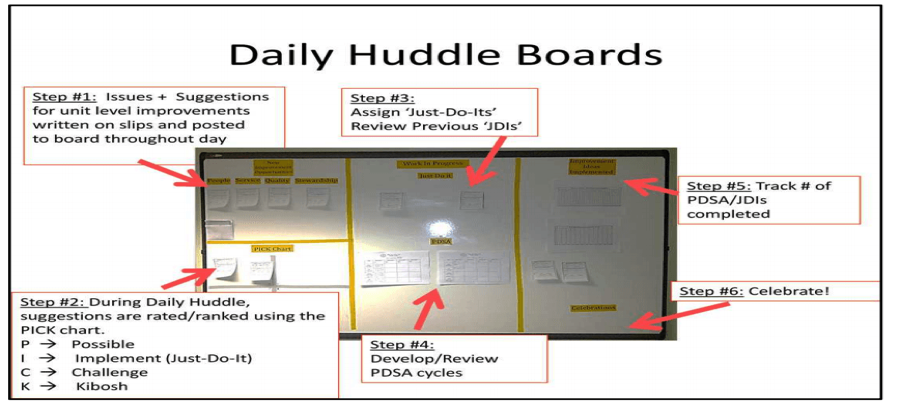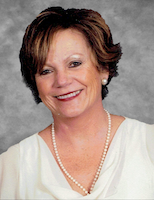BY DEBBIE FRAZIER & BRUCE BELFIORE | September 19, 2017
“When the team comes together to plan on a regular basis using a Huddle Board, we become more high-functioning and efficient and accomplish so much more with our teams.” – Debbie Frazier
Huddle Boards are idea-and-action boards that become the focus of your team meetings, or huddles. They can be paper, white board (with sticky notes!) or electronic. Whatever works best for you. Here is what one looks like:

Note that the Huddle Board can be open to input from team members in advance of your huddle meeting. That way people are ready to speak about their suggestions when the meeting begins, and time is not wasted. People enter the meeting ready to focus on real issues, and move into analysis and decision mode very quickly.
By step two the team is already rating and ranking the suggestions, which go from “Beautiful no-brainer; just do it” to “Cut and kibosh”.
Step three involves assigning thumbs-up projects and reviewing previous “Just do it” projects to ascertain status.
Step four - - PDSA - - is one of those acronym items that gathers several steps together into a tight conceptual framework:
Plan: Develop a plan to test the proposed change
Do: Carry out the test
Study: Observe and learn from the test. Check everything out!
Act: Determine what modification should be made to the test and then implement
Step five is wash, rinse, repeat. Then, Just Do It (JDI).
The process may require several iterations to reach the desired conclusion. That’s ok. Track and document the tests performed, the factors that you see influencing the outcomes, and the adjustments made.
Not every situation will require multiple iterations and tests. It all depends on the complexity of the change or process.
Step six: Celebrate successes!! This is something most of us should do more in the contact center world.
The Huddle Board is a tool, and as such, much depends on how it is used. Here are steps we recommend for effective huddles:
- Establish the routine and involve the right people.
Pre-schedule the day, time and location. Normally 20 minutes suffice. - Develop relationships and designate roles.
- Designate a leader – who brings a “servant-leader” approach. Bring in coaches if useful.
- Use a checklist.
Develop a strong team culture/team spirit and close working rapport. - Evolve and improve over time. Continue to increase team engagement.
How huddles can be beneficial for you as a manager:
- It gives you face-time with your team, to share information in person
- It is a great way to get a “feel” for the morale of the team
- It is an opportunity for YOU to impact their attitude for the day
- You have the opportunity to talk about a new policy or remind them to read a memo or email that may impact their level of service given to the customer
- It is a great time to recognize success. Don’t forget to recognize those that are improving and not just the top performers
You can also recognize something personal about team members such as birthdays, anniversaries, community involvement, etc.
Tips for using Huddle Boards:
- “Perfect is the enemy of good” – You must be willing to experiment and get messy. Visual boards take many shapes and forms. Do they help you focus on the right work and metrics as a team? It’s less important that they look pretty to the outside observer.
- Standard framework with room for variation – Even if there is a standard for what all huddle boards in your organization should look like, there must still be room for variation by unit or team. What’s important to one team may not be important to another. If you’re ready to get started and wonder if there will be an organization standard at some point, don’t wait for it. Just get going and adapt later if a standard appears.
- Find metrics that are meaningful – Ask yourself a few questions. What problems are you trying to solve? What do you need to measure to track progress and show improvement? Shining a bright light on a specific metric may cause some angst but if it’s important, do it anyway.
- You are there to solve problems – Be sure your huddles are not a place where people feel beat up. Create a culture of improvement that is blame-free, transparent, metric-driven and focused on doing better for your employees and your customers. Be willing to tell the “ugly story” about something that doesn’t work. Figure out how to improve it, implement the changes, and measure the results.
- Celebrate your wins – carve out a place on your board where you can highlight successes and celebrate what you’ve done as a team.
- Be creative and have some fun with it – Huddle Boards can take on sports team and car racing themes. The potential for team ownership is that much greater when people can have some fun with it.
Are you intrigued and excited by the prospect of Huddle Boards for your team? If you would like to communicate with a BenchmarkPortal colleague who has first hand experience with Huddle Boards, reach out to Debbie Frazier at Debbie@BenchmarkPortal.com. Also, listen to Debbie and Bruce Belfiore talk about Huddle Boards on CallTalk Radio.
 Debbie Frazier is a Senior Consultant with Benchmark Portal. She has over 3 decades of experience in customer service managing captive agents and most recently a vendor relations manager for outsourced contact center operations both in the US and outside of the US. Her previous responsibilities included recruiting, hiring, quality assurance, workforce management, customer relations and process improvements. Debbie’s background will be a good fit in this new role due to her extensive call center experience.
Debbie Frazier is a Senior Consultant with Benchmark Portal. She has over 3 decades of experience in customer service managing captive agents and most recently a vendor relations manager for outsourced contact center operations both in the US and outside of the US. Her previous responsibilities included recruiting, hiring, quality assurance, workforce management, customer relations and process improvements. Debbie’s background will be a good fit in this new role due to her extensive call center experience.
 Bruce Belfiore is Senior Research Executive and CEO of BenchmarkPortal, custodian of the world’s largest database of contact center metrics. He hosts the monthly online radio show "CallTalk" and is chancellor of The College of Call Center Excellence, which provides courses for call center professionals. He has consulted for many Fortune 1000 companies, helping them to improve the strategic value, efficiency and effectiveness of their customer contact operations. He is the author of the book Benchmarking At Its Best for Contact Centers and holds bachelor’s, MBA and JD degrees from Harvard University.
Bruce Belfiore is Senior Research Executive and CEO of BenchmarkPortal, custodian of the world’s largest database of contact center metrics. He hosts the monthly online radio show "CallTalk" and is chancellor of The College of Call Center Excellence, which provides courses for call center professionals. He has consulted for many Fortune 1000 companies, helping them to improve the strategic value, efficiency and effectiveness of their customer contact operations. He is the author of the book Benchmarking At Its Best for Contact Centers and holds bachelor’s, MBA and JD degrees from Harvard University.



